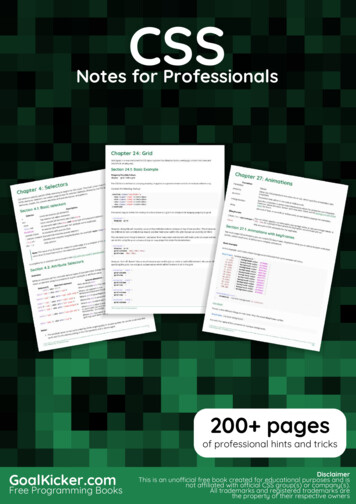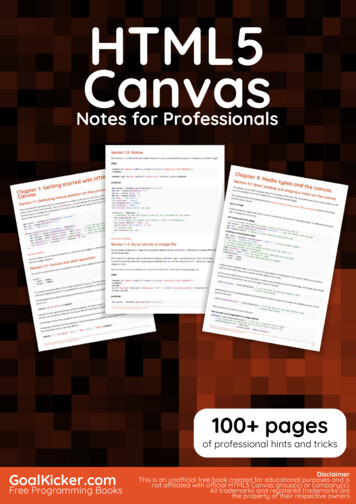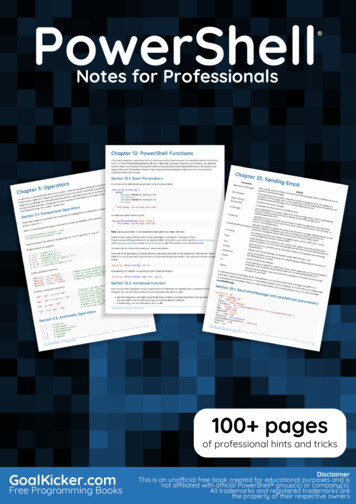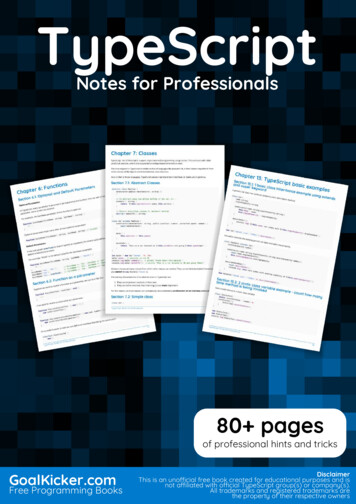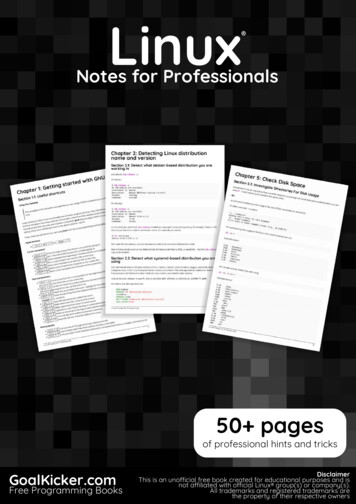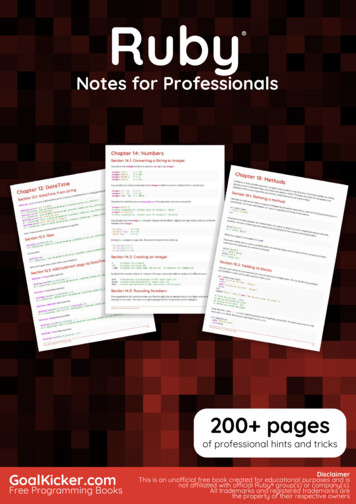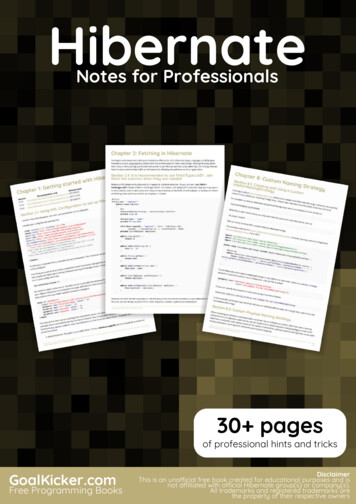
Transcription
HibernateHibernateNotes for ProfessionalsNotes for Professionals30 pagesof professional hints and tricksGoalKicker.comFree Programming BooksDisclaimerThis is an uno cial free book created for educational purposes and isnot a liated with o cial Hibernate group(s) or company(s).All trademarks and registered trademarks arethe property of their respective owners
ContentsAbout . 1Chapter 1: Getting started with Hibernate . 2Section 1.1: Using XML Configuration to set up Hibernate . 2Section 1.2: Simple Hibernate example using XML . 4Section 1.3: XML-less Hibernate configuration . 6Chapter 2: Fetching in Hibernate . 8Section 2.1: It is recommended to use FetchType.LAZY. Join fetch the columns when they are needed. 8Chapter 3: Hibernate Entity Relationships using Annotations . 10Section 3.1: Bi-Directional Many to Many using user managed join table object . 10Section 3.2: Bi-Directional Many to Many using Hibernate managed join table . 11Section 3.3: Bi-directional One to Many Relationship using foreign key mapping . 12Section 3.4: Bi-Directional One to One Relationship managed by Foo.class . 12Section 3.5: Uni-Directional One to Many Relationship using user managed join table . 13Section 3.6: Uni-directional One to One Relationship . 14Chapter 4: HQL . 15Section 4.1: Selecting a whole table . 15Section 4.2: Select specific columns . 15Section 4.3: Include a Where clause . 15Section 4.4: Join . 15Chapter 5: Native SQL Queries . 16Section 5.1: Simple Query . 16Section 5.2: Example to get a unique result . 16Chapter 6: Mapping associations . 17Section 6.1: One to One Hibernate Mapping . 17Chapter 7: Criterias and Projections . 19Section 7.1: Use Filters . 19Section 7.2: List using Restrictions . 20Section 7.3: Using Projections . 20Chapter 8: Custom Naming Strategy . 21Section 8.1: Creating and Using a Custom ImplicitNamingStrategy . 21Section 8.2: Custom Physical Naming Strategy . 21Chapter 9: Caching . 24Section 9.1: Enabling Hibernate Caching in WildFly . 24Chapter 10: Association Mappings between Entities . 25Section 10.1: One to many association using XML . 25Section 10.2: OneToMany association . 27Chapter 11: Lazy Loading vs Eager Loading . 28Section 11.1: Lazy Loading vs Eager Loading . 28Section 11.2: Scope . 29Chapter 12: Enable/Disable SQL log . 31Section 12.1: Using a logging config file . 31Section 12.2: Using Hibernate properties . 31Section 12.3: Enable/Disable SQL log in debug . 31Chapter 13: Hibernate and JPA . 33
Section 13.1: Relationship between Hibernate and JPA . 33Chapter 14: Performance tuning . 34Section 14.1: Use composition instead of inheritance . 34Credits . 35You may also like . 36
AboutPlease feel free to share this PDF with anyone for free,latest version of this book can be downloaded from:https://goalkicker.com/HibernateBookThis Hibernate Notes for Professionals book is compiled from Stack OverflowDocumentation, the content is written by the beautiful people at Stack Overflow.Text content is released under Creative Commons BY-SA, see credits at the endof this book whom contributed to the various chapters. Images may be copyrightof their respective owners unless otherwise specifiedThis is an unofficial free book created for educational purposes and is notaffiliated with official Hibernate group(s) or company(s) nor Stack Overflow. Alltrademarks and registered trademarks are the property of their respectivecompany ownersThe information presented in this book is not guaranteed to be correct noraccurate, use at your own riskPlease send feedback and corrections to web@petercv.comGoalKicker.com – Hibernate Notes for Professionals1
Chapter 1: Getting started with HibernateVersionDocumentation LinkRelease 2/ ion/4.3/ ion/5.0/ 2015-09-01Section 1.1: Using XML Configuration to set up HibernateI create a file called database-servlet.xml somewhere on the classpath.Initially your config file will look like this: ?xml version "1.0" encoding "UTF-8"? beans xmlns :xsi dbc tx maLocation tx-3.2.xsd" /beans You'll notice I imported the tx and jdbc Spring namespaces. This is because we are going to use them quite heavilyin this config file.First thing you want to do is enable annotation based transaction management (@Transactional). The main reasonthat people use Hibernate in Spring is because Spring will manage all your transactions for you. Add the followingline to your configuration file: tx:annotation-driven / We need to create a data source. The data source is basically the database that Hibernate is going to use to persistyour objects. Generally one transaction manager will have one data source. If you want Hibernate to talk to multipledata sources then you have multiple transaction managers. bean id "dataSource"class DataSource" property name "driverClassName" value "" / property name "url" value "" / property name "username" value "" / property name "password" value "" / /bean The class of this bean can be anything that implements javax.sql.DataSource so you could write your own. Thisexample class is provided by Spring, but doesn't have its own thread pool. A popular alternative is the ApacheCommons org.apache.commons.dbcp.BasicDataSource, but there are many others. I'll explain each of theproperties below:driverClassName: The path to your JDBC driver. This is a database specific JAR that should be available onGoalKicker.com – Hibernate Notes for Professionals2
your classpath. Ensure that you have the most up to date version. If you are using an Oracle database, you'llneed a OracleDriver. If you have a MySQL database, you'll need a MySQLDriver. See if you can find the driveryou need here but a quick google should give you the correct driver.url: The URL to your database. Usually this will be something likejdbc\:oracle\:thin\:\path\to\your\database or jdbc:mysql://path/to/your/database. If you googlearound for the default location of the database you are using, you should be able to find out what this shouldbe. If you are getting a HibernateException with the message org.hibernate.HibernateException:Connection cannot be null when 'hibernate.dialect' not set and you are following this guide, there isa 90% chance that your URL is wrong, a 5% chance that your database isn't started and a 5% chance thatyour username/password is wrong.username: The username to use when authenticating with the database.password: The password to use when authenticating with the database.The next thing, is to set up the SessionFactory. This is the thing that Hibernate uses to create and manage yourtransactions, and actually talks to the database. It has quite a few configuration options that I will try to explainbelow. bean id "sessionFactory"class ctoryBean" property name "dataSource" ref "dataSource" / property name "packagesToScan" value "au.com.project / property name "hibernateProperties" props prop key "hibernate.use sql comments" true /prop prop key "hibernate.hbm2ddl.auto" validate /prop /props /property /bean dataSource: Your data source bean. If you changed the Id of the dataSource, set it here.packagesToScan: The packages to scan to find your JPA annotated objects. These are the objects that thesession factory needs to manage, will generally be POJO's and annotated with @Entity. For more informationon how to set up object relationships in Hibernate see here.annotatedClasses (not shown): You can also provide a list of classes for Hibernate to scan if they are not all inthe same package. You should use either packagesToScan or annotatedClasses but not both. Thedeclaration looks like this: property name "annotatedClasses" list value foo.bar.package.model.Person /value value foo.bar.package.model.Thing /value /list /property hibernateProperties: There are a myriad of these all lovingly documented here. The main ones you will beusing are as follows:hibernate.hbm2ddl.auto: One of the hottest Hibernate questions details this property. See it for more info. Igenerally use validate, and set up my database using either SQL scripts (for an in-memory), or create thedatabase beforehand (existing database).hibernate.show sql: Boolean flag, if true Hibernate will print all the SQL it generates to stdout. You can alsoconfigure your logger to show you the values that are being bound to the queries by settingGoalKicker.com – Hibernate Notes for Professionals3
log4j.logger.org.hibernate.type TRACE log4j.logger.org.hibernate.SQL DEBUG in your log manager (Iuse log4j).hibernate.format sql: Boolean flag, will cause Hibernate to pretty print your SQL to stdout.hibernate.dialect (Not shown, for good reason): A lot of old tutorials out there show you how to set theHibernate dialect that it will use to communicate to your database. Hibernate can auto-detect which dialectto use based on the JDBC driver that you are using. Since there are about 3 different Oracle dialects and 5different MySQL dialects, I'd leave this decision up to Hibernate. For a full list of dialects Hibernate supportssee here.The last 2 beans you need to declare are: bean class eptionTranslationPostProcessor"id "PersistenceExceptionTranslator" / bean id "transactionManager"class actionManager" property name "sessionFactory" ref "sessionFactory" / /bean The PersistenceExceptionTranslator translates database specific HibernateException or SQLExceptions intoSpring exceptions that can be understood by the application context.The TransactionManager bean is what controls the transactions as well as roll-backs.Note: You should be autowiring your SessionFactory bean into your DAO's.Section 1.2: Simple Hibernate example using XMLTo set up a simple hibernate project using XML for the configurations you need 3 files, hibernate.cfg.xml, a POJO foreach entity, and a EntityName.hbm.xml for each entity. Here is an example of each using MySQL:hibernate.cfg.xml ?xml version "1.0" encoding "utf-8"? !DOCTYPE hibernate-configuration PUBLIC"-//Hibernate/Hibernate Configuration DTD e-configuration-3.0.dtd" hibernate-configuration session-factory property name "hibernate.dialect" org.hibernate.dialect.MySQLDialect /property property name "hibernate.connection.driver class" com.mysql.jdbc.Driver /property property name "hibernate.connection.url" jdbc:mysql://localhost/DBSchemaName /property property name "hibernate.connection.username" testUserName /property property name "hibernate.connection.password" testPassword /property !-- List of XML mapping files -- GoalKicker.com – Hibernate Notes for Professionals4
mapping resource "HibernatePractice/Employee.hbm.xml"/ /session-factory /hibernate-configuration DBSchemaName, testUserName, and testPassword would all be replaced. Make sure to use the full resource nameif it is in a package.Employee.javapackage HibernatePractice;public class Employee {private int id;private String firstName;private String middleName;private String lastName;public Employee(){}public int getId(){return id;}public void setId(int id){this.id id;}public String getFirstName(){return firstName;}public void setFirstName(String firstName){this.firstName firstName;}public String getMiddleName(){return middleName;}public void setMiddleName(String middleName){this.middleName middleName;}public String getLastName(){return lastName;}public void setLastName(String lastName){this.lastName lastName;}}Employee.hbm.xml hibernate-mapping class name "HibernatePractice.Employee" table "employee" meta attribute "class-description" This class contains employee information. /meta id name "id" type "int" column "empolyee id" generator class "native"/ /id property name "firstName" column "first name" type "string"/ property name "middleName" column "middle name" type "string"/ property name "lastName" column "last name" type "string"/ GoalKicker.com – Hibernate Notes for Professionals5
/class /hibernate-mapping Again, if the class is in a package use the full class name packageName.className.After you have these three files you are ready to use hibernate in your project.Section 1.3: XML-less Hibernate configurationThis example has been taken from herepackage org.hibernate.cfg.Configuration;public class LiveHibernateConnector implements IHibernateConnector StringStringStringStringStringStringStringDB DRIVER NAME "";DB URL "jdbc:h2: /liveDB;MV STORE FALSE;MVCC FALSE";DB USERNAME "sa";DB PASSWORD "";DIALECT "org.hibernate.dialect.H2Dialect";HBM2DLL "create";SHOW SQL "true";private static Configuration config;private static SessionFactory sessionFactory;private Session session;private boolean CLOSE AFTER TRANSACTION false;public LiveHibernateConnector() {config new ector.driver operty("hibernate.show sql",DB DRIVER NAME);DB URL);DB USERNAME);DB PASSWORD);DIALECT);HBM2DLL);SHOW SQL);/** Config connection pools*/config.setProperty("connection.provider vider");config.setProperty("hibernate.c3p0.min size", "5");config.setProperty("hibernate.c3p0.max size", "20");config.setProperty("hibernate.c3p0.timeout", "300");config.setProperty("hibernate.c3p0.max statements", "50");config.setProperty("hibernate.c3p0.idle test period", "3000");/*** Resource mappingGoalKicker.com – Hibernate Notes for Professionals6
dClass(User.class);sessionFactory config.buildSessionFactory();}public HibWrapper openSession() throws HibernateException {return new HibWrapper(getOrCreateSession(), CLOSE AFTER TRANSACTION);}public Session getOrCreateSession() throws HibernateException {if (session null) {session sessionFactory.openSession();}return session;}public void reconnect() throws HibernateException {this.sessionFactory config.buildSessionFactory();}}Please note, that with latest Hibernate this approach doesn't work well (Hibernate 5.2 release still allow thisconfiguration)GoalKicker.com – Hibernate Notes for Professionals7
Chapter 2: Fetching in HibernateFetching is really important in JPA (Java Persistence API). In JPA, HQL (Hibernate Query Language) and JPQL (JavaPersistence Query Language) are used to fetch the entities based on their relationships. Although it is way betterthan using so many joining queries and sub-queries to get what we want by using native SQL, the strategy how wefetch the associated entities in JPA are still essentially effecting the performance of our application.Section 2.1: It is recommended to use FetchType.LAZY. Joinfetch the columns when they are neededBelow is an Employer entity class which is mapped to the table employer. As you can see I used fetch FetchType.LAZY instead of fetch FetchType.EAGER. The reason I am using LAZY is because Employer may have alot of properties later on and every time I may not need to know all the fields of an Employer, so loading all of themwill leading a bad performance then an employer is loaded.@Entity@Table(name "employer")public class Employer{@Id@GeneratedValue(strategy GenerationType.IDENTITY)private Long id;@Column(name "name")private String Name;@OneToMany(mappedBy "employer", fetch FetchType.LAZY,cascade { CascadeType.ALL }, orphanRemoval true)private List Employee employees;public Long getId() {return id;}public void setId(Long id) {this.id id;}public String getName() {return name;}public void setName(String name) {this.name name;}public List Employee getEmployees() {return employees;}public void setEmployees(List Employee employees) {this.employees employees;}}However, for LAZY fetched associations, uninitialized proxies are sometimes leads to LazyInitializationException. Inthis case, we can simply use JOIN FETCH in the HQL/JPQL to avoid LazyInitializationException.GoalKicker.com – Hibernate Notes for Professionals8
SELECT Employer employer FROM EmployerLEFT JOIN FETCH employer.nameLEFT JOIN FETCH employer.employee employeeLEFT JOIN FETCH employee.nameLEFT JOIN FETCH employer.addressGoalKicker.com – Hibernate Notes for Professionals9
Chapter 3: Hibernate Entity Relationshipsusing AnnotationsAnnotation@OneToOneDetailsSpecifies a one to one relationship with a corresponding object.@OneToMany Specifies a single object that maps to many objects.@ManyToOne Specifies a collection of objects that map to a single object.@EntitySpecifies an object that maps to a database table.@TableSpecifies which database table this object maps too.@JoinColumn Specifies which column a foregin key is stored in.@JoinTable Specifies an intermediate table that stores foreign keys.Section 3.1: Bi-Directional Many to Many using user managedjoin table object@Entity@Table(name "FOO")public class Foo {private UUID fooId;@OneToMany(mappedBy "bar")private List FooBar bars;}@Entity@Table(name "BAR")public class Bar {private UUID barId;@OneToMany(mappedBy "foo")private List FooBar foos;}@Entity@Table(name "FOO BAR")public class FooBar {private UUID fooBarId;@ManyToOne@JoinColumn(name "fooId")private Foo foo;@ManyToOne@JoinColumn(name "barId")private Bar bar;//You can store other objects/fields on this table here.}Specifies a two-way relationship between many Foo objects to many Bar objects using an intermediate join tablethat the user manages.The Foo objects are stored as rows in a table called FOO. The Bar objects are stored as rows in a table called BAR. Therelationships between Foo and Bar objects are stored in a table called FOO BAR. There is a FooBar object as part ofthe application.GoalKicker.com – Hibernate Notes for Professionals10
Commonly used when you want to store extra information on the join object such as the date the relationship wascreated.Section 3.2: Bi-Directional Many to Many using Hibernatemanaged join table@Entity@Table(name "FOO")public class Foo {private UUID fooId;@OneToMany@JoinTable(name "FOO BAR",joinColumns @JoinColumn(name "fooId"),inverseJoinColumns @JoinColumn(name "barId"))private List Bar bars;}@Entity@Table(name "BAR")public class Bar {private UUID barId;@OneToMany@JoinTable(name "FOO BAR",joinColumns @JoinColumn(name "barId"),inverseJoinColumns @JoinColumn(name "fooId"))private List Foo foos;}Specifies a relationship between many Foo objects to many Bar objects using an intermediate join table thatHibernate manages.The Foo objects are stored as rows in a table called FOO. The Bar objects are stored as rows in a table called BAR. Therelationships between Foo and Bar objects are stored in a table called FOO BAR. However this implies that there isno FooBar object as part of the application.GoalKicker.com – Hibernate Notes for Professionals11
Section 3.3: Bi-directional One to Many Relationship usingforeign key mapping@Entity@Table(name "FOO")public class Foo {private UUID fooId;@OneToMany(mappedBy "bar")private List Bar bars;}@Entity@Table(name "BAR")public class Bar {private UUID barId;@ManyToOne@JoinColumn(name "fooId")private Foo foo;}Specifies a two-way relationship between one Foo object to many Bar objects using a foreign key.The Foo objects are stored as rows in a table called FOO. The Bar objects are stored as rows in a table called BAR. Theforeign key is stored on the BAR table in a column called fooId.Section 3.4: Bi-Directional One to One Relationship managedby Foo.class@Entity@Table(name "FOO")public class Foo {private UUID fooId;@OneToOne(cascade CascadeType.ALL)@JoinColumn(name "barId")private Bar bar;}@Entity@Table(name "BAR")public class Bar {private UUID barId;@OneToOne(mappedBy "bar")private Foo foo;}GoalKicker.com – Hibernate Notes for Professionals12
Specifies a two-way relationship between one Foo object to one Bar object using a foreign key.The Foo objects are stored as rows in a table called FOO. The Bar objects are stored as rows in a table called BAR. Theforeign key is stored on the FOO table in a column called barId.Note that the mappedBy value is the field name on the object, not the column name.Section 3.5: Uni-Directional One to Many Relationship usinguser managed join table@Entity@Table(name "FOO")public class Foo {private UUID fooId;@OneToMany@JoinTable(name "FOO BAR",joinColumns @JoinColumn(name "fooId"),inverseJoinColumns @JoinColumn(name "barId", unique true))private List Bar bars;}@Entity@Table(name "BAR")public class Bar {private UUID barId;//No Mapping specified here.}@Entity@Table(name "FOO BAR")public class FooBar {private UUID fooBarId;@ManyToOne@JoinColumn(name "fooId")private Foo foo;@ManyToOne@JoinColumn(name "barId", unique true)private Bar bar;//You can store other objects/fields on this table here.}Specifies a one-way relationship between one Foo object to many Bar objects using an intermediate join table thatthe user manages.This is similar to a ManyToMany relationship, but if you add a unique constraint to the target foreign key you canGoalKicker.com – Hibernate Notes for Professionals13
enforce that it is OneToMany.The Foo objects are stored as rows in a table called FOO. The Bar objects are stored as rows in a table called BAR. Therelationships between Foo and Bar objects are stored in a table called FOO BAR. There is a FooBar object as part ofthe application.Notice that there is no mapping of Bar objects back to Foo objects. Bar objects can be manipulated freely withoutaffecting Foo objects.Very commonly used with Spring Security when setting up a User object who has a list of Role's that they canperform. You can add and remove roles to a user without having to worry about cascades deleting Role's.Section 3.6: Uni-directional One to One Relationship@Entity@Table(name "FOO")public class Foo {private UUID fooId;@OneToOneprivate Bar bar;}@Entity@Table(name "BAR")public class Bar {private UUID barId;//No corresponding mapping to Foo.class}Specifies a one-way relationship between one Foo object to one Bar object.The Foo objects are stored as rows in a table called FOO. The Bar objects are stored as rows in a table called BAR.Notice that there is no mapping of Bar objects back to Foo objects. Bar objects can be manipulated freely withoutaffecting Foo objects.GoalKicker.com – Hibernate Notes for Professionals14
Chapter 4: HQLHQL is Hibernate Query Language, it based on SQL and behind the scenes it is changed into SQL but the syntax isdifferent. You use entity/class names not table names and field names not column names. It also allows manyshorthands.Section 4.1: Selecting a whole tablehql "From EntityName";Section 4.2: Select specific columnshql "Select id, name From Employee";Section 4.3: Include a Where clausehql "From Employee where id 22";Section 4.4: Joinhql "From Author a, Book b Where a.id book.author";GoalKicker.com – Hibernate Notes for Professionals15
Chapter 5: Native SQL QueriesSection 5.1: Simple QueryAssuming you have a handle on the Hibernate Session object, in this case named session:List Object[] result session.createNativeQuery("SELECT * FROM some table").list();for (Object[] row : result) {for (Object col : row) {System.out.print(col);}}This will retrieve all rows in some table and place them into the result variable and print every value.Section 5.2: Example to get a unique resultObject pollAnswered getCurrentSession().createSQLQuery("select * from TJ ANSWERED ASW where pol id " pollId " and prf log
Hibernate Hibernate Notes for Professionals Notes for Professionals GoalKicker.com Free Programming Books Disclaimer This is an uno cial free book created for educational purposes and is


